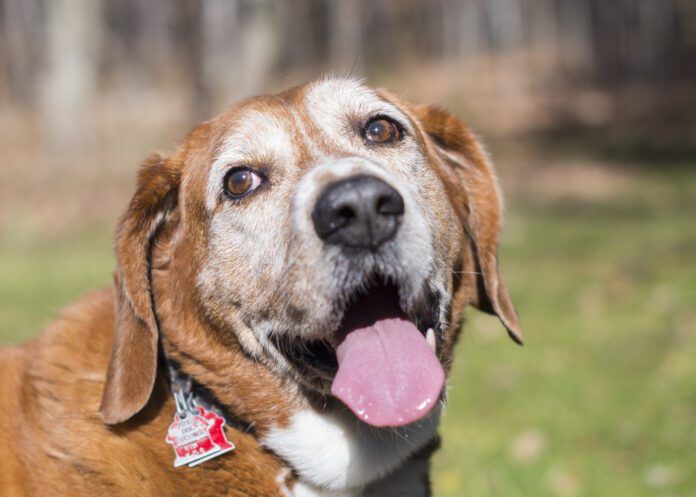
“There is not a ‘one size fits all’ schedule for senior status, as different-sized dogs age at different rates,” says Dr. Robin Downing, Hospital Director for the Downing Center for Animal Pain Management in Colorado. We know from biological markers that metabolic and structural changes occur as dogs age determining their senior status, she says. And size matters.
When Is My Dog a Senior?
Tiny dogs have a longer life expectancy while giant and large breeds are on the other end of the spectrum biologically, aging faster.
- Small/tiny dogs are typically considered seniors around 10 to 11 years.
- Medium-sized dogs usually reach senior status around 8 to 9 years.
- Larger/giant breeds age faster and are usually considered seniors at around 6 to 7 years.
“One important consideration is a dog’s biologic age may or may not match their chronologic age,” says Downing, noting that the rate of aging depends on many factors including genetics and lifestyle. This, she says, gives pet owners a powerful opportunity to help their dogs achieve and maintain a lower biological age than chronological through preventive care.
A recent study using data from the Dog Aging Project found other factors affecting activity over time including the owner’s age, dog and owner characteristics, dog size, and the environment where they live.
Caring for a Senior Dog
When you are caring for an aging dog, there are some things you can do to improve or even extend her life. Helping a senior dog stay healthy can include:
- Keeping your dog a healthy weight is the first line of defense. Your vet can help determine an optimal weight and body composition for your dog.
- Making sure your dog sees a vet at least every six months. Early detection of any potential problems means early intervention, supporting a longer and better life.
- Getting regular exercise. Exercise remains key for maintaining aging muscles and joints. “Move it or lose it.”
- Providing mental enrichment. Seek out safe opportunities for mental and emotional engagement, such as learning new skills or tricks. For more on how to keep your older dog mentally engaged, see “The Importance of Mental Stimulation for Dogs.”
- Don’t forget to socialize! Experiences like cafes and group walks are healthy activities for dogs who like that kind of thing. Honor your dog’s preferences regarding social time.
- Providing regular dental care at home and professional periodontal therapy as needed. Periodontal disease is extremely common in older dogs and can lead to a number of other health problems.
Common Senior Dog Health Problems
Old age is not a disease, yet some health issues are more common in older dogs. Among them are:
- Osteoarthritis (OA)
- Chronic kidney disease
- Congestive heart failure
- Cancer: Have your vet investigate every lump.
- Hearing and vision loss
- Age-related cognitive dysfunction
When it comes to older dogs, less get-up-and-go stamina does not necessarily mean the dog is uncomfortable or in pain. However, a marked decrease in activity and mobility almost always indicates pain, according to Downing. Check out all mobility issues with your vet.
Senior Dog Nutrition
“There is no defined nutrient profile for a “Senior” life stage,” says veterinary nutritionist Dr. Julie Churchill. “This means pet foods labeled for “seniors” is a marketing term and not defined by anyone other than that specific company.”
The American Association of Feed Control Officials (AAFCO) regulates and defines pet food industry standards for a “complete and balanced” diet for life stages of healthy dogs (growth and adult maintenance) or “all life stages.” It does not have a separate standard for senior dogs.
“It isn’t realistic to define a nutrient profile to meet all senior needs because as pets age, just like people, their calorie needs change,” says Dr. Churchill. “An individualized vet-directed feeding plan is the best approach.”
When looking for the right food to feed your senior dog, consider the following:
- Check the WSAVA Global Nutrition guidelines when choosing a “complete and balanced” diet. See also “How to Choose a Dog Food: Factors to Consider.”
- Monitor protein intake. Dogs commonly need more protein as they age. Check with your vet or a canine nutritionist to see what they recommend for your dog.
- Have fresh water available at all times and monitor your dog’s intake. No only is good hydration important to overall healthy, a sudden increase in thirst can signal illness. Consult your vet if you notice your dog is drinking more than usual.
- Feed the correct amount for a lean body condition. A good starting point is WSAVA’s adult dog calorie ranges for an ideal body condition. However, you will need to pay attention to your dog’s weight and overall condition. Her needs may vary significantly from the average and will likely change as she ages.
- To reduce caloric intake for weight management, seek a lower calorie, higher protein food.
- Use meal toppers sparingly as overuse can create a nutritional imbalance.
When Is the Best Time to Start Feeding a Dog a Senior Diet?
As with everything else related to canine aging, the right time to switch to a diet designed to support a senior dog depends on the individual dog and her diet.
“When a dog enters what would be the second half of his/her expected lifespan, then they should get a thorough evaluation by their veterinarian,” says Churchill. This includes a physical exam, lab work and a diet evaluation to ensure their current diet is meeting all nutritional needs. “The diet may or may not be labeled ‘senior’ food, but it should be one that matches the individual dog’s needs,” she says.
Monitoring nutrition, ensuring proper exercise and enrichment, and scheduling regular vet visits can create opportunities to positively affect your dog’s aging process. “All in all, helping a dog age gracefully provides so much enjoyment, says Downing. “We just need to be aware, vigilant, and proactive.”


